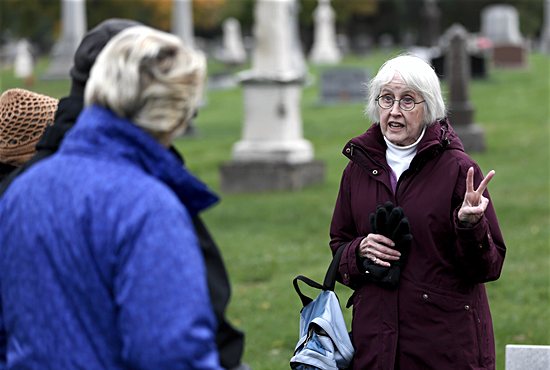
To know a city, people must walk in the footsteps of those who came before them.
Or take a walking tour of the city’s cemeteries.
The history of St. Paul is written in stone. And the stones that speak of days gone by are to be found in the cemeteries, said Mary-Benton Hummel, a St. Paul Community Education instructor whose popular Historic Cemetery Walking Tour course includes one of the most significant Catholic cemeteries in the Twin Cities.
“You can tell so much about a city from its cemeteries,” she said.
Calvary Cemetery is spread across a 100-acre bluff along Front Avenue in St. Paul. Established on the site in 1856 by Bishop Joseph Cretin, the first bishop of the then-Diocese of St. Paul (now the Archdiocese of St. Paul and Minneapolis), Calvary marks the final earthly resting place for the remains of many of the city’s biggest names in business and industry, politics, law and — of course — religion.
The names live on, and so do the stories about them and their times, certainly in the fact-packed mind of Hummel. Anyone who moves about the metro area knows some of them, if only by logistical necessity: Larpenteur, Robert, Pierce Butler, Ireland, Cretin, Dowling, Bremer, Hamm, Prince. They’re the stuff of street maps, required learning for all who traverse the city to any degree, leaping out to passersby from street signs, schools, bridges, banks and city parks.
Hummel knows them all. She spent hours on end researching the history of St. Paul cemeteries for her master’s thesis — about seeing city history through the perspective of its cemeteries — while at Hamline University in 1991. Community Education organizers asked her to teach a class on cemeteries shortly thereafter.
“I am not the least bit solemn about cemeteries,” she said. That approach stands her in good stead as a city historian, especially given some of the city’s early history — from a rough-hewn pioneer outpost to a kind of sanctuary city for the nation’s criminal class in the 1920s. It’s all catalogued in the city cemeteries, if people just know how and where to look, Hummel said.
TOURING CALVARY CEMETERYCalvary Cemetery is located at 753 Front Ave., St. Paul, and open daily from 8 a.m. to dusk.
For more information, call the cemetery at 651-481-8866.
The season has closed on Mary-Benton Hummel’s walking tours of St. Paul cemeteries, but she plans to offer them again through St. Paul Community Education in the spring. For more information, visit spps.org/commed.
The diocese first planted Calvary Cemetery on a plot of downtown ground running along Third Street (Kellogg Boulevard), near the riverfront. Not long thereafter, the diocese relocated the cemetery to a larger area near the present-day junction of Interstate 94 and 10th Street, according to Hummel. But even that move proved ephemeral. In 1856, the diocese moved the cemetery again, to the large plot of land on Front Avenue, well to the north and west of the main population center.
“The land was affordable,” Hummel explained. People thought the diocese’s leaders were crazy to put a cemetery in such a remote area, she said, but the city eventually grew up, around and well beyond the cemetery.
James J. Hill bought a piece of the land from the diocese to use for railroad tracks for his Great Northern railway line, which extended to Seattle. The tracks still border the cemetery at its back-end, although they’re now owned by the BNSF Corp. Hill also purchased a family plot at Calvary, but used it just once — for the burial of his 2-year-old daughter who died of an unknown illness. (The family ultimately relinquished its plot at Calvary and is today buried at Resurrection Cemetery in Mendota Heights.)
Calvary is home to the remains of more than 104,500 people — and counting. “We do 150-250 burials a year,” said Linda Radtke, office manager for Calvary Cemetery, which, along with Resurrection, is among the five cemeteries managed by The Catholic Cemeteries.
The cemetery draws visitors from around the world, Radtke noted. In addition to being the final resting place for prominent Minnesotans, the cemetery is also known for its wealth of beautiful, original statuary and monuments.
One of the most important names in the cemetery, from the perspective of Minnesota history, is that of Mary Ann Bilansky. A native of North Carolina, Bilansky in 1860 found herself residing in St. Paul and married, apparently unhappily, to Stanislaus Bilansky. The marriage ended when Stanislaus died of rat poisoning, administered on the sly by his wife, according to police. Mary Ann was subsequently convicted of first-degree murder and sentenced to be hanged. Despite an outcry from the citizenry and even the State Legislature, Mary Ann was hanged in 1861 — making her the first, and also the only, woman ever judicially executed in Minnesota. Bishop Thomas Grace, a South Carolina native, ministered to Bilansky in her final moments, Hummel said.
Bishop Grace is buried there, too, along with the archdiocese’s other early leaders: Bishop Cretin, Archbishop John Ireland and Archbishop Austin Dowling.
Calvary Cemetery also contains the remains of David Hogan, a Prohibition-era criminal who suffered the distinction of becoming the first-known person killed by a car bomb. Hogan had taken up occupancy in the city. As a known gangster, he was expected to pay off the police in return for his being allowed to move about the city freely. He refused to play by police rules, however, which led to the police figuring out how to plant and trigger a bomb in his car. Al Capone paid for the funeral, including the grave at Calvary Cemetery. “It was said to be quite an impressive funeral,” Radtke said.
Other important historical figures buried in the cemetery include Frederick McGhee, St. Paul’s first black criminal lawyer; E.L. Masqueray, architect of the Cathedral of St. Paul in St. Paul and the Basilica of St. Mary in Minneapolis; and Mother Seraphine Ireland, Archbishop Ireland’s sister and one of hundreds of religious sisters and priests buried in a special section of the cemetery.




